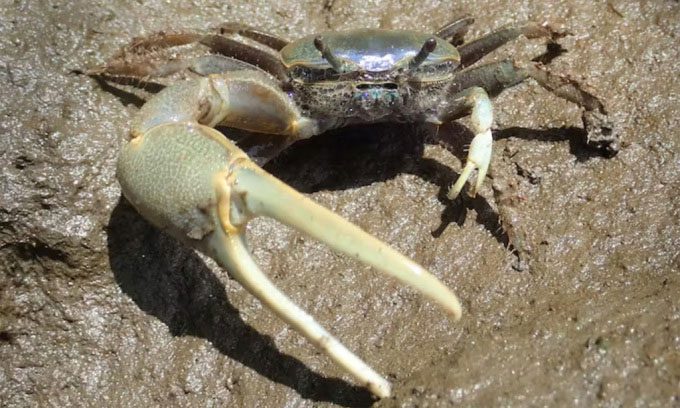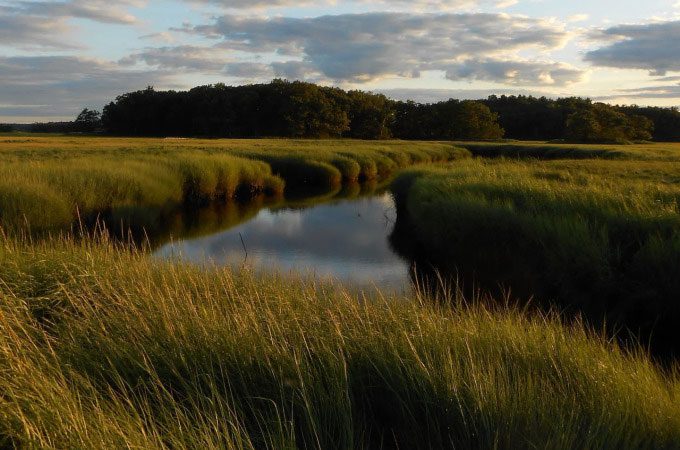Rising temperatures are causing blue crabs to migrate further north, invading salt marshes and harming local ecosystems.
Great Marsh is located in Maine, a large bay of the Atlantic Ocean on the eastern coast of North America. The marshes along the bay are important breeding grounds for many bird species. However, the waters there are warming faster than most places around the globe. Along with the warm water, warm-water species, including the blue crab, are beginning to appear, as reported by Yahoo News on December 31.

Male blue crab with a special large claw. (Photo: David S. Johnson).
The male blue crab is characterized by its oversized claw, which it uses to attract females and defend itself against rivals. They are rapidly migrating, partly due to the presence of juveniles. While adult crabs crawl along the mud, the young crabs swim and are carried by the currents. The warm water helps them complete their life cycle and the currents are transporting the next generation of crabs further north.
David Samuel Johnson, an associate professor of marine science at the Virginia Institute of Marine Science, was surprised to see blue crabs appear in the Great Marsh. He was also amazed at the degree of their impact on the marsh.
Research over several decades south of Cape Cod indicates that eelgrass thrives better in the presence of blue crabs. Their waste and burrows release nutrients that promote grass growth. They act as earthworms of the southern salt marshes, aiding plant growth.
However, the situation in the Great Marsh is different. The crabs’ burrowing has reduced the biomass of shoots and leaves by 40% and the biomass of roots by 30% in the Great Marsh during the summers of 2020 and 2021. While blue crabs do not eat grass, their digging damages the roots of Spartina grass. Southern plants have adapted to this damage and now benefit from the crabs, but northern plants have not yet adapted.
This damage could continue to affect the rest of the food web in the Great Marsh. Many insects, spiders, snails, and small crustaceans feed on the grass. They, in turn, become food for fish, shrimp, and crabs. A reduction in plant biomass could lead to a decrease in fish and shrimp populations. Many bird species that breed in or stop at the marsh during migration could also be affected.

Eelgrass is essential for the ecosystem of the Great Marsh. (Photo: David S. Johnson).
Spartina grass in the north may gradually adapt to the presence of blue crabs, as might other organisms here. But in the meantime, the crabs could exacerbate the impacts of climate change in the area.
Rapid sea level rise due to increasing temperatures poses a risk of the Great Marsh being submerged. For millennia, salt marshes have managed to cope with rising sea levels by gradually building up higher. Plants contribute to the marshes’ elevation by trapping sediment carried in with each tidal surge. A decrease in grass could lead to fewer marshes or result in marshes being submerged.
Blue crabs also reduce the carbon storage capacity of the Great Marsh. Each year, dead plant roots are buried in oxygen-poor soil. As a result, decomposition slows significantly, allowing carbon to accumulate and be stored. This transforms salt marshes into important carbon storage reservoirs, preventing carbon from escaping into the atmosphere and contributing to climate change. However, crab burrowing stimulates decomposition. Dead plants begin to rot, and previously buried carbon is released.
2023 has set records for ocean heatwaves worldwide, and with greenhouse gas emissions still rising, warming will continue. Climate-driven migratory species are not considered invasive, but they can change ecosystems, as seen with blue crabs in the Great Marsh. Therefore, understanding this process and the adaptability of ecosystems is crucial for scientists.


















































